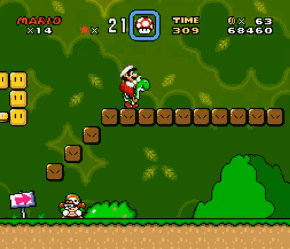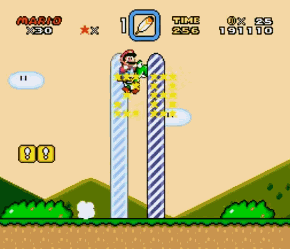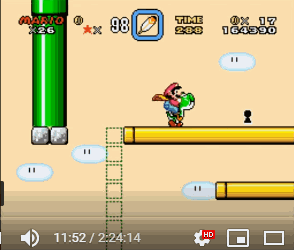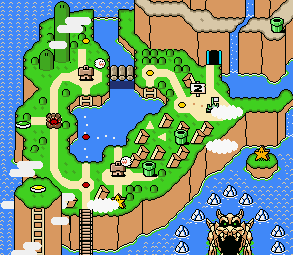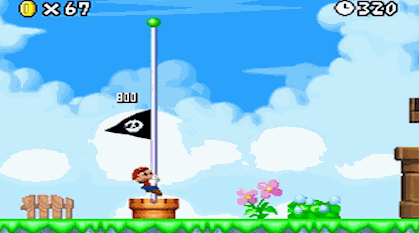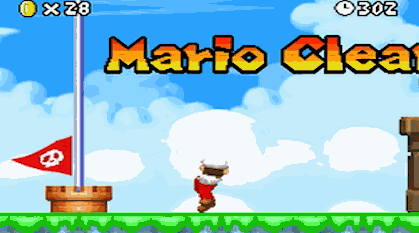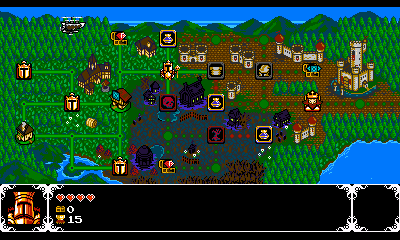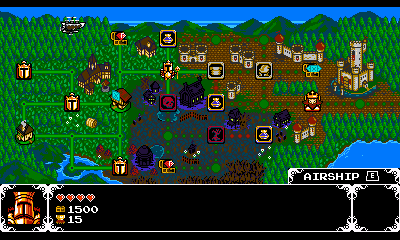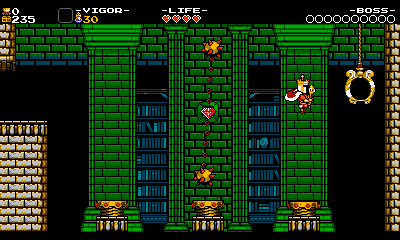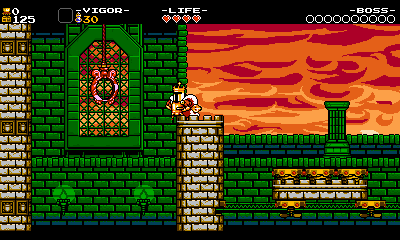:quality(80)/f/93161/1638x1216/a485782b86/featlogo.png)
Knight Knight's Map: Building Secret Paths
Hey, Pathfinders! While developing King of Cards, we thought a lot about how to increase the excitement of the game on the map...
/f/93161/1920x1080/6cfafa9f68/featuredcardkk.png)

Hey, Pathfinders! While developing King of Cards, we thought a lot about how to increase the excitement of the game on the map. Shovel Knight: Shovel of Hope started as a game with a map heavily inspired by Mario 3. The map was structured so that players would be encouraged to try out different levels if they were having a hard time with any one in particular. Players would have the flexibility to travel in a specific stage order to get to a bonus, or to travel along a different route to find reprieve in a village more quickly. The map was a way to do some world building, and a means to pepper in some flavorful ideas that couldn’t be communicated in the core set of stages. Through the map, we wanted to reinterpret the Mega Man experience of facing 8 core baddies by selecting them from a menu, and extend the depth of that concept just a little bit. This map structure was also used for Shovel Knight: Plague of Shadows.
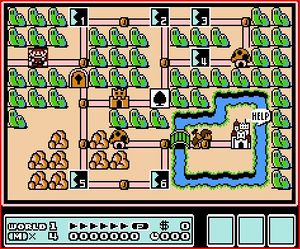
For our next game, Shovel Knight: Specter of Torment, we wanted to try the pure Mega Man route: 8 stages you could select on a menu, no questions asked! This map style would offer a more direct and focused experience than Shovel Knight. We’d save the experiential depth for Specter Knight’s home base. This layout helped Specter’s quest feel more like a serious mission and less like an epic saga, and logically enhanced the tone and themes of the game.
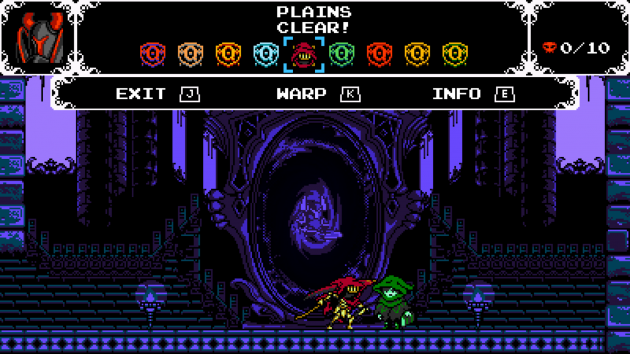
With King of Cards, we thought it’d be fun to try going in the opposite direction with traversing the world. After all, King Knight’s the grandest character in Shovel Knight’s Order of No Quarter, so his adventure should feel like an appropriately epic journey! We thought, “Let’s try to make a map where path choices are something you really care about.” We weren’t entirely sure what that meant in any detail. So, we started small. We thought we might lean more heavily into the Mario inspiration, where players wouldn’t need to clear every stage. Then, we’d create more, shorter stages, with multiple exits! This new possibility positioned the world map itself as a bigger part of the game’s experience.
We pondered how to build a map that felt like something that contained as much excitement and character as the games that inspired us. We knew we wanted stages to have alternate routes that opened up new paths on the map. The challenge was figuring out how to execute that vision while simultaneously keeping the game fun and clear!
Building the map!
We soon decided that King of Cards would have more than one world map to give the overall experience an irrefutable sense of grandeur. In contrast to Shovel of Hope (which had a scrolling map), we kept King Knight’s maps focused on one screen each, as we wanted them to feel both unique and digestible. The goal was to create something almost like a paper map, or a map you might find in a board game, where armchair kings could plot paths to conquer!
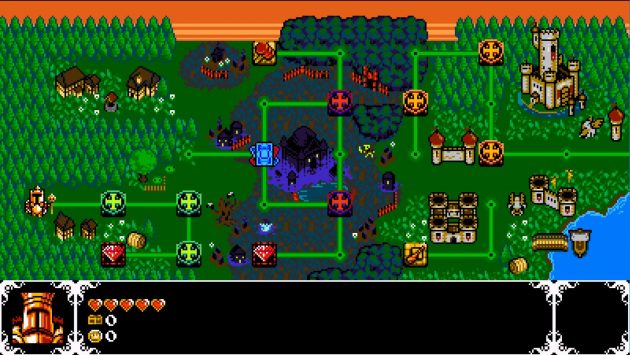
Here’s one of the early versions of the first world map that we shared at PAX. Although it was created specifically for convention-goers (so players could only play the stages in each given section), you can see that all the paths were laid out in a similar manner to the original Shovel Knight. The main difference being that the sections of the map don’t appear to link up! Your path to some areas (like the relic node in the bottom right) were totally obscured. Beating a stage or finding its secret exit would unlock a new path, but these hidden paths would only be revealed after they’d been found in a stage.
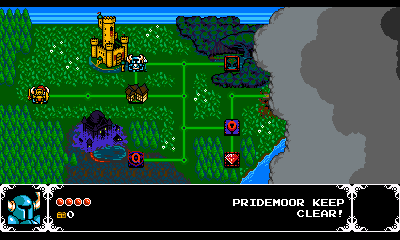
This was a new design challenge for us. In Shovel of Hope, all the paths on the map were visible at all times, and your progress was blocked by locks and level nodes. Beating a level would cause the level node and locks to disappear, allowing the player to progress. We only had one hidden path in the whole game that appeared at the very end – and it existed only to subvert your expectations!
What we immediately understood from looking at King Knight’s map is that it was hard to actually plan a route without being able to see the paths. How do you know what stage to play to reach a goal? How do you know what stages have secret exits? How can you determine the shortest path to the end of the game, or which path has the most gold? Which path will reward you with the most items? What to do?!
Looking for inspiration
Clearly, we must have forgotten how all those inspiring Mario games worked! This problem had been solved for sure, right? We just needed to find the right point of reference…
Super Mario World stood out to us as a game with a successfully complex map. In our view, this pinnacle of Mario map design effectively focused on a fun world layout. So, we started there and made some observations:
The first area on the map immediately shows the multiple paths you can take and where they lead. You can see some kind of fortified end goal on the right implying this is the way forward: the road to defeat the villain. On the left, something that resembles an optional path appears, looking a little more adventurous and fun! You can see where you’re able to walk, and – if you defeat a stage with a yellow indicator – you can guess as to what path it will unlock. That’s all well and good… but what about secret exits?
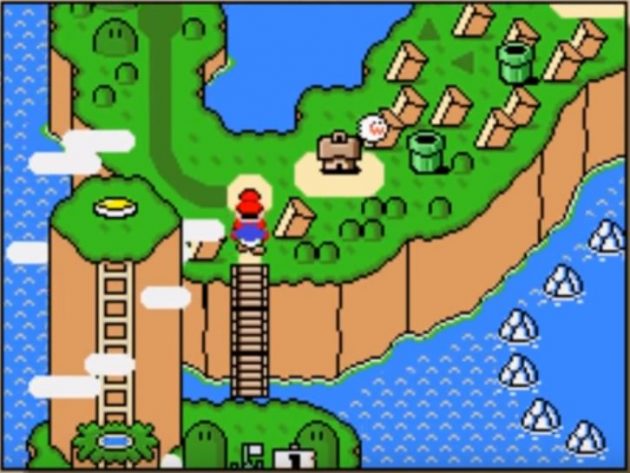
In Mario’s second area, you arrive at a stage with multiple exits. This stage has a red indicator to signify this special trait! At this point, we have to come clean… developing King of Cards was the first time anyone in the office understood the difference between yellow and red levels on Mario’s map.
When you clear a stage normally, it opens the path on the left. When you take the secret exit, it opens up a path you can’t see!
In addition, when you clear either path in the stage, the color of the node on the map doesn’t change! Maybe we did something wrong…that can’t be right- why not change the color from red to yellow after you’ve beaten a path to let you know you’ve made progress? Is the secret level completely hidden? How would you plan a path?
We came to the realization that Mario was simply trying to achieve different goals than we were! Mario is more concerned about the surprise and delight of finding a stage or discovering a new route. They want the player to explicitly know there’s a secret path (which is why the level flashes red), so they don’t waste their time looking for one. We can only imagine the ultimate goal must be to make stages feel full of surprises, and to make progression feel exciting. This can be most clearly understood by looking at the final Donut Plains map and by seeing what happens when you clear a Ghost House without having uncovered a secret stage.
Did you catch what happened? When you beat the Ghost House, the undiscovered hidden stages appear!
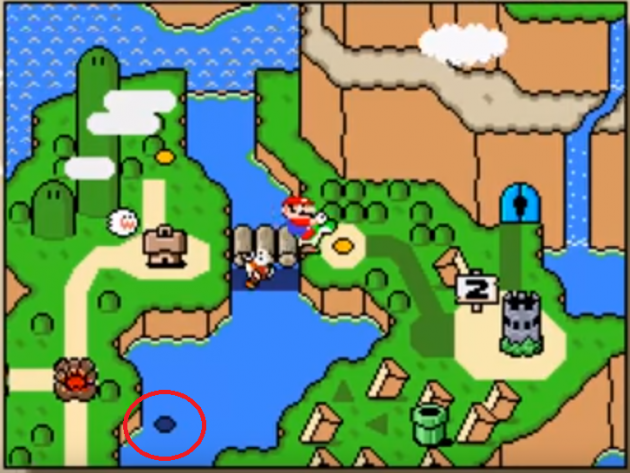
At some point, Mario Team must’ve decided they didn’t want players to completely miss the idea of secret exits and hidden stages, so they left helpful clues if players passed them up. As you can see in the completed map, the colors of the level nodes never change. The nodes are there to indicate what type of level you are playing as opposed to the level’s progress.
Even in the years since Super Mario World, you can see Nintendo still using this same logic in the new Super Mario games. Here’s New Super Mario Bros DS before its levels are cleared (notice the red stage denoting two exits):
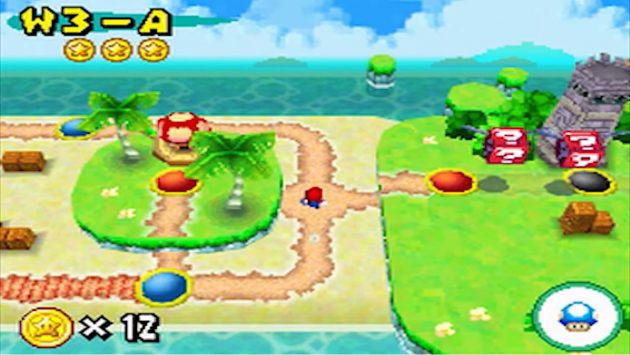
Beat it the normal way, and you’ll uncover the path you can already see. Beat the stage the secret way, and discover an entirely new path.
So we’ve studied a lot of maps… now what? Well, by learning some lessons from Mario maps (and other maps too!) as reference, we were better able to understand what we wanted, and what made sense for our game.
Red Paths and Dotted Lines
Here’s the final map layout we landed on for the first world:
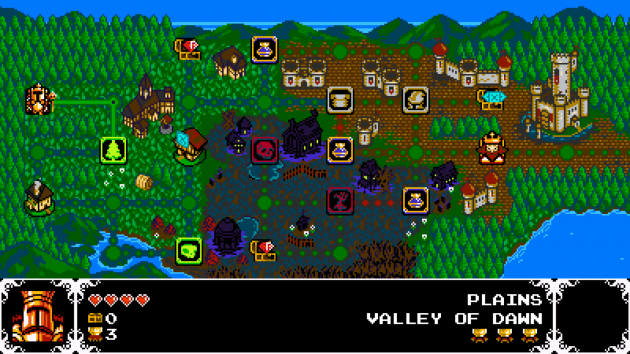
As you can perhaps see, we were just a little inspired by Mario’s use of red! Green paths are normal, while red paths denote a secret. We replaced Shovel of Hope’s locking node system with paths that would unlock once the stage was beaten. Solid paths indicate a walkable path, while dotted lines require traversing a stage first. In contrast to our PAX demo, we decided that, in order to have strategic planning on the map, we had to make all the paths visible at all times (as well as whatever rewards were at the end!).
Above, you can see how reaching a stage’s main exit will unlock the green path, and reaching the secret exit will unlock the red path. King Knight’s head will appear when either exit is found, but the icon continues to flash when the content has not been cleared, indicating there’s still something to do!
We designed all of this so the player has all the information they need to make decisions. They can see at a glance where they might want to go and what stages are blocking their path. They can anticipate what path might lead them to the goal they are seeking, and they can know if a stage has multiple routes. Best of all, this information can be learned naturally without tutorials. Nice!
Our plan for King Knight’s map may not provide as many surprises as Mario’s map, but it allows for much more strategy and enhances the themes and gameplay of King of Cards. To account for the lack of surprises on the map paths, we added more wandering encounters and bonuses that could pop up after completing a stage to retain that element of discovery.
Building Secret Exits into Stages
Of course, King of Cards’ secret exits aren’t only in service of the world map! Most of the game is about bashing and spinning your way gloriously through stages. We solved secret exits on the map, but how would we introduce the concept of secret exits in a stage? In other Shovel Knight games, we were used to having one main path. We may have had small asides and secret rooms, but never an entirely new stage branch with its own exit! That came with its own set of problems. Our big concerns were:
Making sure the difference between the main path and secret path would be clear. How do you know what path you’re on when you are playing?
Confusing secret or optional rooms with secret exits. Shovel Knight is chock-a-block with secrets already, and those rooms are tricky enough to communicate to the player. How do we handle adding the entirely new concept of a secret exit?
How would you know what path on the map would be unlocked after completing a stage? We had to mentally connect the exit in the stage to the exit on the map so players could plan a route.
Avoiding repeating stage content. We knew we’d be asking players to replay a stage to find both exits. We resolved not to make players visit the same part of the stage too much. That’s boring!
Using our “red = secrets” philosophy, we attempted to solve (a) the confusion with secret/optional rooms and, (b) clarifying the difference between main paths and secret branches. This can be understood most easily in one of the early-game secrets shown below
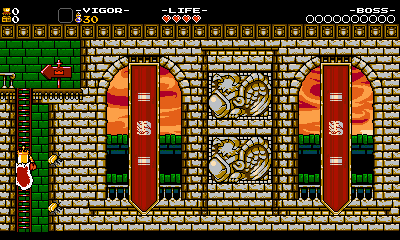
Without spoiling how it’s conveyed, the secret in this stage requires you take an out-of-the-way red ladder from a previous screen. When you see a red element like this, you will know that room is leading you to a secret exit! The red arrow sign cements that message, and appears again in every stage with a secret exit (along with a unique music jingle) to let you know there won’t necessarily be a way back. Sometimes, that sign can appear before the path as a clue, or as a signifier once you’re on the path, but it should always be clear that you are taking the path to the secret exit. In this way, players know they are on the secret path as soon as they find it!
To connect the exit in the stage to the exit on the map, we simply colored the secret exit red to match the path! How ingenious we are! If you missed the other clues, there’d be no confusion once you reached the exit!
If all else failed, we tried to make the secret exit areas a tad more challenging than areas on the main paths. This would make the rewards feel a bit sweeter, while simultaneously making it clear that you were not taking the standard route!
To avoid forcing players to repeat large swaths of stage content, we focused on designing the levels so the secret paths were usually near the Checkpoint that split the stage down the middle. We also made sure that you wouldn’t have to replay an auto-scroller or other piece of content that might try your patience.
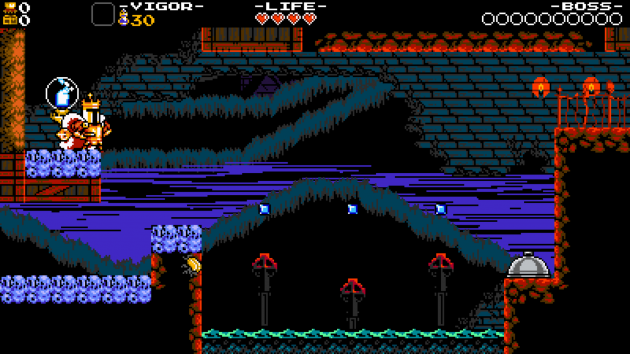
The secret exit is oh so close! You’ll have to play to find out how to reach it!
This consistency also lets players more easily intuit where secret exits might be, and they’d only have to repeat about half the stage. This allowed us to make the second half of stages more difficult, as players would only have to overcome these challenges once. All of these decisions had the cool effect of giving each section of the level a very memorable, solid structure!

Finally, we tried to connect the treasure and rewards on the map with the challenges of the stages.
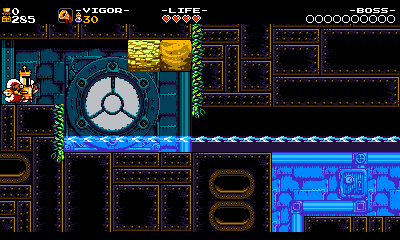
For example, King Knight’s Scepter of Swiftness, which allows him to dash across the surface of water, is acquired near water stages where it’s very useful! Utilizing a new relic on your journey can get you thinking about the stage in a fresh and interesting way. When you add up all of these details and start thinking about the map as you are playing the stage, you really start feeling like a master strategist!
Take the Path
Hope you enjoyed reading about our “Path”ological obsession! It was quite the journey to craft the secret exits in Shovel Knight: King of Cards. We worked hard to make navigating secret paths both legible and fun, and tried to make a world map system that felt different and unique amongst the platforming greats. We hope you enjoy choosing your own path to take through King Knight’s grand adventure!

